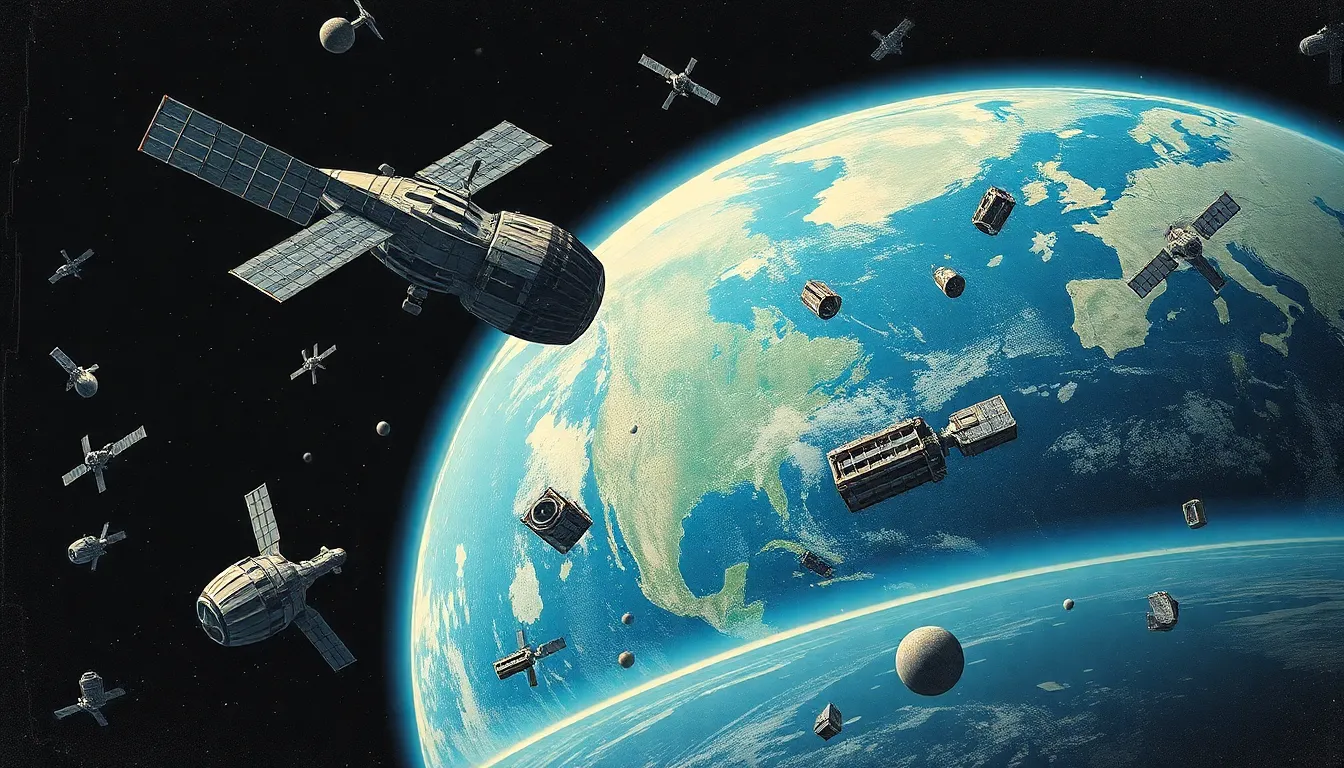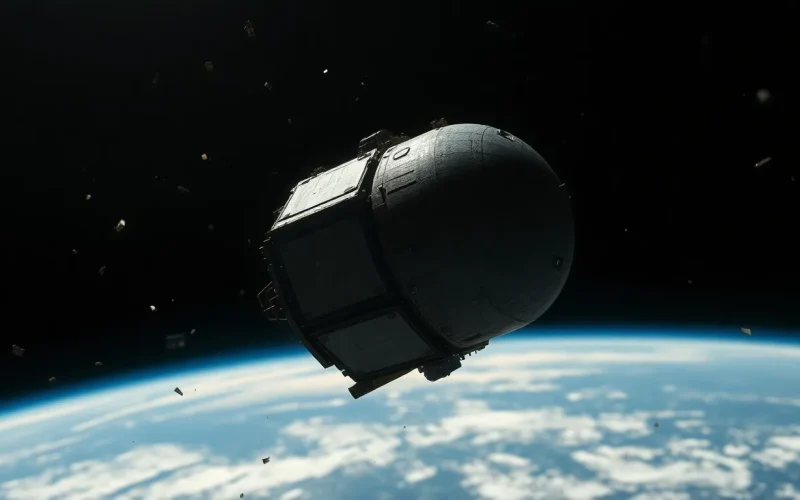Table of Contents
ToggleIn the vast expanse of space, there’s more than just twinkling stars and distant planets—there’s a whole lot of junk floating around. Yes, space debris is the cosmic clutter that’s become a pressing concern for astronauts, satellites, and even the occasional space tourist. Picture a game of dodgeball, but instead of rubber balls, it’s defunct satellites and old rocket parts zooming past at breakneck speeds.
Overview of Space Debris
Space debris refers to non-functional human-made objects in orbit. This includes defunct satellites, spent rocket stages, and fragments from collisions. Each piece poses risks to operational spacecraft and astronauts. In 2021, the number of tracked objects exceeded 30,000, indicating the extent of this issue.
Increasingly, space missions encounter challenges due to this debris. Each collision generates additional fragments, compounding the problem. Certain objects orbit Earth at speeds exceeding 17,500 miles per hour, which can cause catastrophic damage upon impact.
Monitoring efforts involve various organizations, including NASA and the European Space Agency. These entities track debris using radar and optical telescopes. They assess the potential for collisions with operational satellites. For instance, in 2020, a close encounter between a satellite and debris prompted a maneuver to avoid collision.
Strategies for mitigation aim to reduce the generation of new debris. International guidelines recommend deorbiting defunct satellites within 25 years after mission completion. Achieving this goal enhances safety for future missions.
Technological advancements also contribute to addressing the debris challenge. Innovative capture mechanisms and removal missions are under development. Projects in the planning stage include nets and harpoons designed to capture large debris pieces.
Collaboration among nations and private companies proves crucial for effective management. Sharing data and technologies fosters a more coordinated response to this global challenge. With increased awareness and efforts, the future of space safety looks promising.
Types of Space Debris

Different categories of space debris exist, each posing unique challenges to operational spacecraft and safety. Understanding these types aids in developing effective mitigation strategies.
Active Satellites
Active satellites function within their intended purpose. These operational satellites serve communication, navigation, and scientific objectives. Tracking involves continuous monitoring to ensure their paths remain clear. Over 10,000 active satellites orbit Earth as of 2021. With their crucial roles, ensuring these satellites avoid collisions has top priority. Various space agencies coordinate efforts to enhance their safety protocols.
Non-Functional Satellites
Non-functional satellites are defunct objects that no longer serve any mission. Aging satellites, once vital for data collection, now drift unused in orbit. These objects pose collision risks, generating more debris as they deteriorate. Approximately 2,800 defunct satellites orbit Earth today, contributing to the congestion in space. Regulations call for their deorbiting within 25 years post-mission, yet many remain in orbit. Efforts to address this challenge involve tracking these non-functional objects closely.
Rocket Parts
Rocket parts constitute another significant category of space debris. Spent rocket stages and fairings, left after launch, orbit Earth and contribute to the clutter. Thousands of rocket components reside in space, often becoming hazards to other operational spacecraft. These remnants can generate collisions that produce smaller fragments, escalating the debris problem. Innovations aim to retrieve and repurpose these parts to minimize risk. Improving tracking and removal of rocket debris remains essential for future space missions.
Causes of Space Debris Generation
Space debris generation results from various activities and incidents related to space exploration. Understanding these causes is crucial for addressing the ongoing debris challenge.
Launch Activities
Launch activities contribute significantly to space debris. Each rocket launch generates debris from discarded components such as stages and fairings. As of 2021, thousands of these objects orbit Earth, remaining as remnants of past missions. Spacecraft often shed materials during ascent or separation, creating additional threats to operational satellites. Over 300 rocket launches occurred in 2021, further exacerbating the debris problem.
Collisions in Space
Collisions in space frequently result in the creation of debris fragments. When operational satellites collide, they can generate hundreds or thousands of pieces of debris. For instance, the 2009 collision between an Iridium satellite and a defunct Russian satellite resulted in approximately 2,000 debris pieces. Spacecraft traveling at speeds of over 17,500 miles per hour intensify the risk of devastating collisions, which subsequently compound existing debris issues.
Mission Failures
Mission failures often lead to the generation of non-functional debris. Malfunctions can occur during or after launch, resulting in defunct satellites that remain in orbit. As of 2021, around 2,800 non-functional satellites contribute to space clutter. Failed missions may leave components drifting in space, threatening operational satellites and crewed missions. Regular monitoring is necessary to mitigate the risks associated with these defunct objects, as each failure increases the likelihood of additional debris creation.
Impact of Space Debris
Space debris poses substantial threats to various aspects of space exploration and satellite operations.
Threats to Operational Satellites
Operational satellites number over 10,000 and are vital for communication, navigation, and scientific research. The presence of space debris increases collision risks that can damage these assets. Events like the 2009 collision between an Iridium satellite and a defunct Russian satellite demonstrate the potential for catastrophic fragmentation. Each collision creates additional debris, compounding the hazard for active satellites. Continuous monitoring helps identify potential threats, allowing satellites to perform avoidance maneuvers when necessary. Moreover, the risk of debris impacts can lead to costly damages, potentially leading to mission failures and interruptions in essential services.
Risks to Human Spaceflight
Human spaceflight faces extreme risks from space debris, jeopardizing the safety of astronauts aboard missions. Spacecraft travel at velocities exceeding 17,500 miles per hour, making even small pieces of debris capable of catastrophic damage. Collisions with space debris can threaten life-support systems and jeopardize mission objectives. Astronauts rely on spacecraft equipped with shielding to minimize risks, but no system offers complete protection. Regular assessments, along with adherence to international guidelines for space debris management, ensure higher safety standards for crewed missions. Developing technologies for debris capture and removal can further enhance the safety of human spaceflight in the future.
Solutions and Mitigation Strategies
Addressing space debris involves multiple innovative strategies to enhance safety in orbit.
Active Debris Removal
Active debris removal focuses on capturing and deorbiting defunct satellites and large debris items. Various technologies, like nets, harpoons, and robotic arms, are under development to tackle larger pieces. For instance, the European Space Agency’s RemoveDEBRIS mission tests different capture mechanisms. Successful retrieval of debris prevents collisions, significantly decreasing the total amount of space junk. Collaboration among private companies and government agencies is essential for deploying these technologies effectively.
Policy Development
Policy development plays a crucial role in managing space debris mitigation efforts. Many nations now emphasize guidelines for deorbiting defunct satellites within 25 years after mission completion. The U.S. Federal Aviation Administration enforces strict regulations for satellite launches to minimize debris creation. Establishing legal frameworks supports accountability among satellite operators for responsible debris management. Enhanced policies ensure that future missions incorporate safer design principles, reducing risks associated with space debris.
International Cooperation
International cooperation fosters a unified approach to combatting space debris challenges. Agreements among countries, such as the UN Space Debris Mitigation Guidelines, promote best practices in satellite operations. Nations share data on tracking debris to enhance monitoring efforts globally. Joint missions, like active debris removal projects, benefit from collaborative technology development. These partnerships improve safety in space for all stakeholders involved in satellite operations and human spaceflight activities.
Space debris presents a critical challenge that demands immediate attention and action. The risks it poses to astronauts and operational satellites cannot be overstated. As the number of launches continues to rise, so does the potential for collisions and the creation of more debris.
Innovative technologies and international cooperation are key to addressing this growing problem. By implementing effective mitigation strategies and adhering to established guidelines, the space community can work together to enhance safety.
With ongoing efforts to develop debris removal techniques and improve monitoring systems, there’s hope for a safer future in space exploration. The responsibility lies with all stakeholders to ensure that space remains a viable environment for generations to come.





